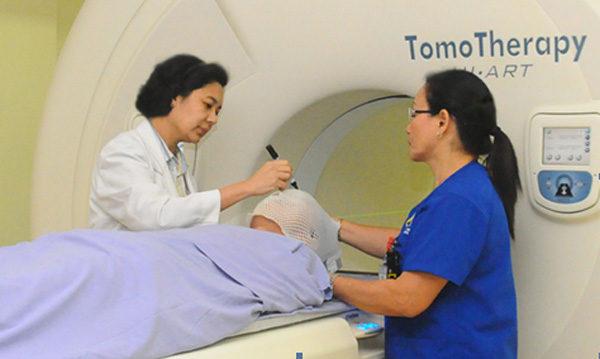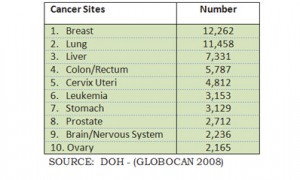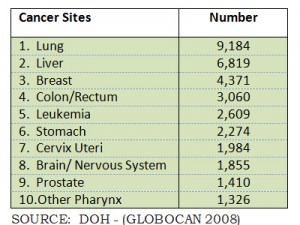(U.S. Poet Laureate Donald Hall wrote an entire book of poems, titled “Without”, about his experience taking care of his wife, the poet Jane Kenyon, as she was dying of leukemia. Many of the poems are untitled, and one of them goes:
“Dying is simple/she said./’What’s worst is… the separation’/When she no longer spoke,/they lay alone together, touching/and she fixed on him/her beautiful enormous round brown eyes,/shining, unblinking,/and passionate with love and dread.”
The words written by Hall have a very personal significance to me now—I never imagined, in the course of publishing this issue of our special supplement, that I would experience the challenge and emotional roller coaster faced by those who care for a loved one with cancer—my father was diagnosed with non-small cell lung cancer.
And so, this issue became a personal journey for me, as well, and the interviews and research done for this article was no longer just for the benefit of our readers but also a source of hope and comfort: after all, acquiring knowledge about a serious (or even terminal) illness lets us feel a measure of control over it, even though such knowledge does not always result in a cure; it can be a tool for coping with the emotional, psychological, and physical difficulties that go with the experience. – Ed.)
Facing Cancer
Lung cancer is one of the most difficult cancers to treat. This is because it’s a type of cancer that spreads to other organs of the body—a process known as “metastasis”. According to Dr. Guia Elena Ladrera, an oncologist at the Lung Center of the Philippines, our lungs are very vascular (having a lot of blood vessels) organs because they act to take in oxygen and put this oxygen in our blood.
This blood passes through the lungs’ blood vessels, where they get oxygen, and then proceed to bring this oxygen to all the other parts of the body. Unfortunately, in the case of lung cancer, cancer cells are also able travel through the lungs’ network of blood vessels and spread to the other organs.
According to Dr. Ladrera, cancer cells begin as normal cells in our body. However, when exposed to substances called carcinogens, they genetically mutate to become abnormal cells. These abnormal cells multiply and grow, creating more and more cancer cells in the body. Such cancer cells compete with regular cells in absorbing the body’s nutrients. As more cancer cells multiply, more normal cells are killed. Eventually, the organ or organs attacked by the cancer fails and shuts down.
Several factors are present in the formation of cancer. Carcinogens, of course, are usually blamed as the culprits, but immunity and genetics also play their part.
Dr. Ladrera said that a strong immune system can protect against cancer. This is because immune system cells attack and destroy cancer cells to keep them from growing and destroying a person’s health. However, the immune system is not always able to do this. When the immune system fails to detect cancer cells, the latter are able to grow and multiply.
Right now, the type of cancer which is a cause for concern in the Philippines is breast cancer—and October has been declared Cancer Awareness Month by the Philippines’ Department of Health (DOH). Although medicines and treatments for this disease have advanced to the point where the patient’s chances for survival have significantly increased, it is still a serious, potentially fatal illness. Breast cancer affects Filipino females and Filipino males as well, although the number of male patients is less by comparison.
According to the DOH, breast cancer remains the number one cause of cancer death among women. Also, the leading cancer site in the Philippines is still the breast, occurring more often at that site compared to the lungs. As of 2010, it is estimated that three out of 100 Filipinas are at risk of getting cancer. One out of every 100 Filipinas die from breast cancer before age 75.
Fortunately, early detection of breast cancer greatly increases a patient’s chances for survival and recovery.
Standard Treatment
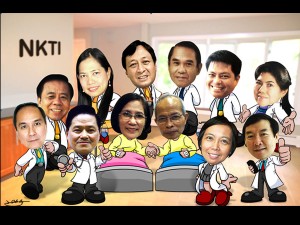
In the Philippines, oncologists follow the standard treatment for cancer as determined by Western medical science. This standard treatment includes surgery, chemotherapy, and radiation therapy. The success of this treatment depends on several factors: a) A person’s state of health and resilience; b) The stage of cancer when it is detected and treated; and c) The type of cancer tumor involved (there are several types) and how susceptible it is to the treatment.
Usually, a person’s age is not a major contributor on success for cancer treatment. For example, there could be a strong 80-year-old patient and another patient, who is a bedridden 30-year-old. Between the two of them, it’s the 80-year-old patient who is better able to withstand the effects of cancer treatment—and may also have a greater chance of recovery.
In general, the healthier and stronger a person’s body is, the greater chances he or she has to recover from cancer. Younger patients also have a greater chance of recovery compared to older patients. This is because a strong, healthy body not only helps fight off cancer cells but also helps a person recover faster from surgery, and cope with the debilitating side effects of chemotherapy and radiation therapy.
In my father’s case, we face bigger challenges. For one thing, he’s already in his 60s. He’s also not in the best of health ever since he suffered from a stroke eight years ago. In fact, he could only take in food through a tube in his stomach. Stem cell was also no longer a practical treatment.
With all these considerations in mind, the family opted for a milder type of chemotherapy for my dad. Surgery was out of the question, as his body would not be able to take the physical trauma involved. Radiation therapy, in our view, could do more harm than good. So the option we took was to give him, along with the supportive and symptomatic treatments, a milder form of chemotherapy pill as his medication.
While chemo pill’s side effects are “milder” in comparison to other chemotherapies, the side effects are still uncomfortable, to say the least, especially for my dad, who has to put up with itchy skin rashes on top of his breathing difficulties and other symptoms.
The doctors told us that the chemo pill would not result in an actual cure for my father. At most, what it could do is control the tumor in his lung, so that it does not get bigger—but that’s something no doctor could guarantee either. Faced with all these, we thought that with so many health challenges stacked against my dad, it was better to start focusing on his quality of life. If it was indeed just a matter of time before the cancer takes him, then we wanted to look for alternative treatments that would at least improve his quality of life, if not actually save it.
Tomotherapy
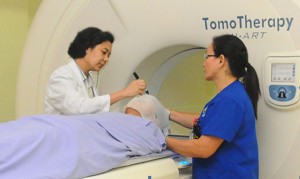
While exploring options for my father’s treatment, we also discovered that the Makati Medical Center has added a new procedure called TomoTherapy. Essentially, this treatment is a revolutionary form of radiation therapy for cancer.
The usual radiation therapy tends to harm more of the healthy tissue around the tumor or cancer sites because the dose of radiation is aimed in a less precise manner.
Using TomoTherapy, however, a doctor can correctly identify and locate tumor sites and the tumors with great accuracy. By using a high-tech system that combines integrated computer tomography (CT) with advanced software, it sends a precisely aimed, image-guided beam of radiation to cancerous tumors. This lessens the exposure of healthy tissue to the radiation.
Most importantly, TomoTherapy reduces many of the common side effects that occur with radiation treatment. “Very often, a tumor as well as normal organs shift from their original location due to many factors including weight loss which alters a patient’s anatomy, or as a consequence of the actual treatment itself. This may result in under or over dosage during treatment if these movements are not accounted for,” explained Dr. Kathleen Baldivia, Radiation Oncology Section Head at MakatiMed.
Using TomoTherapy, Makati Medical Center oncologists can adjust the patient’s treatment plan to account for changes in tumor volume and anatomy during the course of treatment. The prescribed radiation dose distribution can also be monitored and maintained according to these changes.
Integrative Medicine
With the Philippine as a rich source of alternative therapies, we wanted to choose the therapies that did not contradict good sense or medical science. We decided to consult with two alternative medicine doctors, Dr. Sam Dizon of Nurture Spa and Dr. Mikey Vergara of The Farm of San Benito. Both of them are medical doctors in Western medicine but they both decided to add alternative therapies to their medical practice.
“What we need more in the Philippines is not really alternative medicine but ‘integrative medicine’. This means that while we accept Western medical science, we also do not turn our backs on other systems of medicine—like Oriental medicine from China, for example. We should not dismiss such medical knowledge outright because they also have a track record of being effective”, explained Dr. Vergara
“Alternative modalities from the East came as a result of observation and tradition. What I use are modalities that not only have good traditional use–thousands of years to be exact–but have scientific reasons for how they work, and are duplicable and safe. That way, we can defend our protocol even with the most vehement critics. And as Hippocrates said, ‘Do no harm’, said Dr. Dizon.
“At the same time, there are therapies in other medical systems that make sense and have a track record of being effective. This is why it’s important for Western trained doctors to learn what other schools of medicine have to contribute. For example, the effectiveness of acupuncture is now recognized in the West.”
Both Dr. Dizon and Dr. Vergara are examples of such doctors who are more open-minded. They recognize that Oriental Medicine from China, Ayurvedic medicine from India, and other non-Western medical knowledge deserve our attention and can be effective as well.
“What we refer to as ‘alternative’ medicine works from a different paradigm compared to Western medicine. The Western approach is that, if you get sick, you are given a pill to cure your illness. That’s it.
“Most alternative treatments that approach health and healing through traditional and natural mean benefit the patient in this way: by allowing him or her heal from within. This healing from within happens in two ways. First, by strengthening their immune systems; and second, through the restoration of optimum body processes and activities.
“Such an approach helps your body get stronger, get cured from within. It’s more than just giving a cure. It’s all about being healthy and enabling your body to protect itself against illness and curing itself when it gets sick.
“That said, we should point out that alternative therapies take time. When someone has a serious infection, or is in need of surgery, Western medicine is very effective for that. When it comes to acute, especially emergency cases, Western medicine is very good. Its view of the human body is from a technician’s perspective. If a body part goes wrong, we do surgery or we replace it,” explained Dr. Vergara.
In my father’s case, we decided to spare him from the side effects of the chemo pill by giving him alternative medicines. Dr. Sam Dizon prescribed counterparts of the medications that my father was taking for his condition. Dr. Dizon didn’t forbid our use of chemo pill, but he said that the alternative medications he prescribed could be used to support my father’s health and help him deal with the side effects of the chemotherapy.
Combining Strenghts
Former Health Secretary Jimmy Galvez-Tan, who is a medical doctor as well as an integrative medicine practitioner also shared some of his insights about cancer. He pointed out that cancer is a disease with many contributing factors—there is never just one single cause.

And since prevention is always preferable to seeking a cure once the disease takes hold, Dr. Galvez-Tan gave a few suggestions on how we can prevent cancer from occurring.
“Since cancer is a multi-factorial disease, prevention can be done in multiple ways. A strong human immune system plays a huge role in the prevention of or recovery from cancer. The immune system keeps the body from developing diseases and protects it from harmful organisms.
“Our immune system can be strengthened by many non-pharmacologic means and evidence-based methods. Increasing or strengthening of the immunity can be done by: a) Sleeping for at least 8 hours or more in full darkness; b) Exercise of at least 30minutes to one hour per day; and c) Freedom from psychosocial or emotional stressors or proper management of these.
“Furthermore, being able to express love, having doses of laughter, leisure and positive outlook in life, or meditation, etc., are non-pharmacologic ways to increase immunity,” he said.
Dr. Galvez-Tan also pointed out that nutrition plays an important part in strengthening our bodies to help prevent cancer.
“Nutrition has a big role in preventing or recovering from cancer. Evidence-based researches prove that fruits, vegetables, complex carbohydrates and deep sea-fish, all have the necessary nutrients, fiber and other substances that can help the recovery of the body from the disease—and may also prevent cancer from occurring.”
For Dr. Galvez-Tan, both Western and non-Western medicine have much to contribute to each other’s efforts to treat cancer and other diseases. According to him each medical system has its own positive strengths, and when these are combined, they can produce a synergy of effect that is beneficial to the patient.
“Western medicine has provided great breakthroughs in the medical field especially in the diagnostic procedures, surgery and cure of certain diseases. It has also provided deeper understanding of the conditions and treatment modalities. It relies mainly and strictly to mechanized diagnostic procedures, laboratory tests and synthetic pharmacologic methods.
While Western medicine focuses more on the biomedical aspect of disease, alternative medicine, on the other hand, has a holistic approach in the human health and wellness. It targets the spiritual environmental, and psycho-social and emotional aspects of the person and mainly concerns on maintaining quality of life, promotion of health and wellness,” he explained.
This integration of Western and non-Western medicine is not a new thing, according to Dr. Galvez-Tan. He noted that the division between “Western” and “non-Western” medicine is simply a product of perceptions and attitudes.
“Many countries like China, Korea, Germany, Netherlands, among others, have combined the Western and alternative medicine, and have been applying Integrative Medicine in their practice. The World Health Organization (WHO) has advocated the integration of traditional medicine into coventional medicine and primary health care since the Alma Ata Declaration of 1978,” he said.
Making the choice
After a few days of administering these alternative medications to our dad, we noticed that the color was coming back in his cheeks and that his bowel movement has become more regular. He also didn’t have the skin rashes anymore. There were no guarantees, of course that the alternative medicine would cure him but we have seen that our dad was much more comfortable.
My dad’s case is an extreme one—his prognosis was never really good to begin with. The Western-trained doctors who looked at him were not giving us false hopes. Our decision to go for an integrative medicine approach, combining Western and non-Western medicine, is one that is meant to provide him with quality of life, not a cure. And we have seen that he felt much better.
That’s the best we can hope for right now, short of a miracle. Still, I am sharing this story because I have learned that in cases of end-stage cancer, there are still many mysteries, many challenges that we face, despite the remarkable advances in Western medicine.
After my experience working with doctors who treated my father, I realized that we are very fortunate that we live in the Philippines; in the Philippines, we have advanced Western medical knowledge and the latest equipment, medication, and protocols for treating cancer—and all these are combined with the friendly, competent, and compassionate care that our medical professionals, from medical and laboratory technicians to nurses, to cancer specialists, extend to patients.
Words are not enough to express the high-level of care and support that my father and my entire family have received from our Filipino doctors and medical professionals—on the part of these experts in Western and Integrative medicine.
Our experts in Integrative medicine also offer very effective advice in healing the body from within. They are able to combine Alternative medicine with Western medical knowledge in order to prescribe dietary regimens; safe, alternative medicines; and give advice on lifestyle changes—all meant to let the body get rid of toxins, boost its immunity, and strengthen its ability to fight cancer and other illnesses, using the body’s own natural defenses.
As was mentioned earlier, treating cancer requires boosting the immune system, and this is achieved not only by medical means. Feeling loved, being able to laugh, to be cheerful, and to feel hope—all these contribute to a patient’s recovery and healing from cancer. These intangible immunity boosters are received by patients under the care of Filipino doctors and medical professionals, who are known the world over for their compassion, cheerfulness, and kindness towards their patients.
Even a beautiful, relaxing setting helps boost the immune system of a cancer patient and the Philippines is rich in serene natural settings of breath-taking beauty, from beaches to rolling hills and verdant landscapes. For patients from overseas, Filipinos’ friendly and hospitable nature, as well as their being conversant in English, will be a boon when they travel in urban areas and tourism destinations in our tropical islands.
My faith in the Philippines as an ideal destination for patients—whether struggling with cancer or other illnesses–from overseas, both foreigners and those of Filipino descent, has been confirmed and rewarded.
Ultimately, the choice falls on the patient and his or her loved ones when it comes to the various options for cancer treatment. They can choose to go for the Western protocol for cancer treatment or they may choose alternative, non-Western therapies. In my father’s case, we have so far chosen to integrate both the Western and non-Western modalities, with guidance from experts in these fields.
I also realized that integrative medicine should be an area that everyone concerned with health and wellness should learn about. Truly, the quest for health and wellness is something that one does for a lifetime—not just for oneself but to benefit others, as well.
Top 10 Leading New Cancer Cases in 2010 in the Philippines (Both Sexes)
Top 10 Leading New Cancer Deaths in 2010 in the Philippines (Both Sexes)

